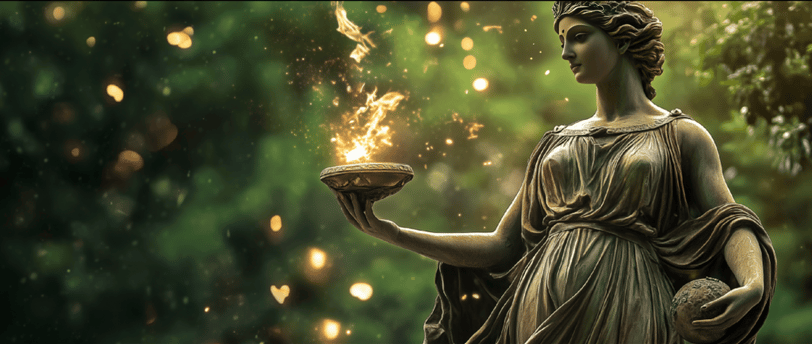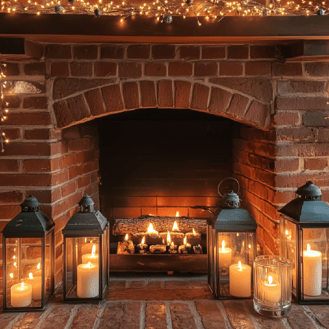Hestia – The Goddess of Hearth, Home, and Sacred Warmth
Explore the timeless wisdom of Hestia, Goddess of Hearth, Home, and Sacred Warmth. This engaging post delves into her origins, symbols, and role in human development while offering practical ways to honor her today. It serves as your guide to embracing Hestia’s grounding energy and divine glow.
GODDESSES
Goddess Hive
12/30/20245 min read


Welcome, Goddess Hive! Some links in this blog are affiliate links. Meaning, if you choose to shop through the links on this page, a small percentage of the sale will go to me at no additional cost to you. Thank you for your support. Goddess bless.
Inviting Hestia’s Glow
Imagine stepping into a space that instantly feels like home—a soft golden glow emanates from a central flame, inviting peace and calm to settle in your heart. This isn’t just ambiance; it’s the essence of Hestia, the Greek Goddess of the hearth, home, and sacred flame. For centuries, her steady, nurturing presence has symbolized warmth, belonging, and the spiritual heart of humanity.
Hestia’s influence extends beyond mythological tales; she’s an archetype of stability, simplicity, and sacred connection. Today, as our lives grow ever more hectic, her presence offers an anchor—a reminder of the beauty in quiet, intentional moments. Let’s journey into the heart of Hestia, exploring her origins, symbols, and enduring relevance, and discover how to invite her energy into our modern lives.
Hestia’s Origin and Practical Function in Human Development
Hestia is one of the original Olympian deities, born to Cronus and Rhea, and the eldest sibling of Zeus, Poseidon, Hera, Demeter, and Hades. As the firstborn, she was also the first to be swallowed by her father and the last to be freed, making her both the eldest and the youngest of her divine siblings. This paradox reflects her role as a timeless, grounding force in Greek mythology.
In ancient Greece, Hestia’s domain was the hearth—the physical and spiritual center of every home and community. The hearth was more than a place for cooking; it was where families gathered, meals were shared, and rituals were performed. The fire burning in the hearth was considered sacred, and maintaining it was an act of devotion to Hestia. Her presence ensured the stability and harmony of the household, making her an integral part of daily life.
From a practical standpoint, Hestia’s role symbolized unity and continuity. Her steady flame represented the interconnectedness of family and community, reminding people of their shared humanity and the importance of nurturing relationships. In this way, she was both a protector and a unifier, fostering a sense of belonging and safety.
Who is Hestia?
Hestia is a unique deity in the Greek pantheon, known for her gentle yet powerful energy. Unlike other Olympians who sought attention and grandeur, Hestia’s presence was quiet and unassuming. She chose not to engage in dramatic myths or rivalries, instead dedicating herself to maintaining peace and stability.
Hestia’s followers were not confined to a specific sect or group. In ancient Greece, her worship was universal, as every household and city-state honored her through the hearth. Her presence was felt in daily rituals, such as lighting the morning fire, offering the first portion of food, and extinguishing the flame at night.
Artifacts associated with Hestia are rare, as her worship was less about grand temples and more about personal, everyday practices. However, representations of her can be found in ancient pottery and statues, often depicting her as a modestly dressed woman holding a flame or sitting near a hearth. The hearth itself—a central feature in ancient homes—is perhaps her most enduring artifact, embodying her presence and purpose.
The Sacred Symbol of Hestia
Hestia’s sacred symbol is the hearth flame, a timeless representation of warmth, connection, and life. The flame is both literal and metaphorical, symbolizing the light of home, the spark of life, and the energy of community.
In modern times, the hearth flame can be interpreted as any central source of warmth and connection—a fireplace, a candle, or even the kitchen stove. These symbols remind us of Hestia’s enduring presence and her role in fostering harmony and togetherness.
Did Hestia Have a Consort?
Unlike many deities in Greek mythology, Hestia remained unmarried and unattached. Both Poseidon and Apollo sought her hand in marriage, but she declined, choosing instead to remain a virgin goddess. This decision was not out of disinterest but a deliberate act of devotion. By remaining unmated, Hestia symbolized purity, independence, and the sacred focus of her energy on the hearth and home.
Her choice to remain unattached also set her apart from other Olympians, emphasizing her role as a stabilizing force free from the entanglements of rivalry or personal ambition. In this way, she became a universal figure, accessible to all and beholden to none.
Controversies and Modern Minimization
Hestia’s absence from many mythological tales and her lack of dramatic narratives have contributed to her being overshadowed by other Olympian gods and goddesses. In modern culture, where bold, dynamic characters often take center stage, her quiet, steady energy is sometimes overlooked.
Additionally, the rise of patriarchal systems in history minimized the importance of hearth-centered rituals, which were often maintained by women. As societies moved away from communal living and toward individualism, the sacredness of the hearth and, by extension, Hestia’s presence, was diminished.
However, as interest in feminine spirituality and domestic harmony resurges, Hestia’s energy is being rediscovered and celebrated. Her subtle yet profound influence is gaining recognition in modern spiritual practices, where balance and simplicity are valued.
Modern Relevance of Hestia
In a fast-paced, technology-driven world, Hestia’s energy is more relevant than ever. She reminds us to slow down, create intentional spaces, and nurture our connections with ourselves and others. Her presence encourages mindfulness, grounding, and the cultivation of sacred spaces in our homes and lives.
Hestia’s emphasis on simplicity and stability offers a counterbalance to the chaos of modern life. By embracing her energy, we can create homes that are not just physical structures but sanctuaries of peace and connection.
Connecting with Hestia in Daily Life
Here are some simple yet powerful ways to invite Hestia’s presence into your daily life:
Light a Candle: Dedicate a candle as your hearth flame. Light it with intention, inviting Hestia’s warmth and peace into your space.
Cook with Intention: Treat your kitchen as a modern-day hearth. Prepare meals with love and mindfulness, infusing them with Hestia’s nurturing energy.
Create a Hearth Space: Designate a cozy corner in your home as a sacred space. Add candles, warm textiles, and meaningful decor to make it a place of comfort and connection.
Practice Gratitude: Begin or end each day with a simple thank-you to Hestia for the blessings of warmth, love, and safety in your life.
Declutter: Simplify your space to create harmony and invite Hestia’s grounding presence.
Hestia’s presence is subtle but profound, reminding us of the beauty in simplicity, the power of connection, and the sacredness of home. By inviting her energy into our lives, we can create spaces that nourish our souls and foster deep, meaningful connections. Light a candle, share a meal, and embrace the steady warmth of Hestia—her presence is already with you, waiting to be noticed.
FAQs About Hestia
Q: How is Hestia worshiped today? Modern worship of Hestia often involves lighting candles, creating sacred spaces, and practicing mindfulness in the home.
Q: What does Hestia’s flame symbolize? Hestia’s flame represents warmth, connection, and the spiritual heart of home and community.
Q: Is Hestia relevant outside of Greek mythology? Absolutely! Hestia’s themes of warmth, stability, and connection are universal, making her energy accessible to anyone seeking balance and peace.
Q: Can men and femmen connect with Hestia? Yes! Hestia’s energy is inclusive, offering guidance and grounding to anyone who seeks her presence.
Q: How can I learn more about Hestia? Books like Greek Gods & Heroes by Robert Graves and resources like Theoi Project provide deeper insights into Hestia’s mythology and significance.
Credible Sources for Further Exploration:





About us
The content provided on OMG, including blog posts, rituals, prayers, meditations, and other materials, is intended for informational, educational, and spiritual enrichment purposes only. It is not a substitute for professional medical advice, diagnosis, or treatment. If you have any concerns regarding your physical or mental health, please consult a qualified healthcare profession.
Take care of yourself first, then take care of everyone else. That is the nature of Goddess-ship.
Be well. Goddess Bless.
Empowerment
Empowering femininity through education and self-care.
Goddess
goddesshive@ohmygoddess.com
© 2024. All rights reserved.
